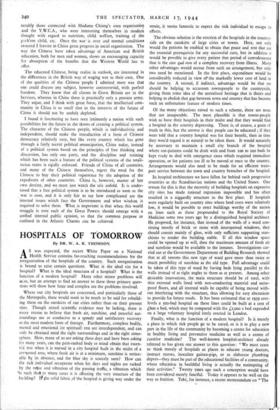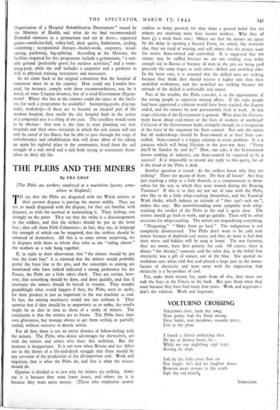HOSPITALS OF TOMORROW
By DR. W. A. R. THOMSON
AS was expected, the recent White Paper on a National Health Service contains far-reaching recommendations for the reorganisation of the hospitals of the country. Such reorganisation is bound to raise certain questions. What is the ideal site for a hospital? What is the ideal structure of a hospital? What is the function of a modern hospital? Many other minor problems will arise, but an attempt to find an answer to these three primary ques- tions will show how large and complex are the problems involved.
Where our city hospitals are concerned, and particularly those of the Metropolis, there would seen to be much to be said for rebuild- ing them on the outskirts of our cities rather than on their present sites. Though actual scientific evidence may be lacking, there is every reason to believe that fresh air, sunshine, and peaceful sur- roundings are as conducive to a speedy and satisfactory recovery as the most modern form of therapy. Furthermore, complete bodily, mental and emotional (or spiritual) rest are interdependent, and can only be obtained amid the right surroundings and in the right atmo- sphere. How, many of us are asking these days and have been asking for many years, can the pain-racked body or mind obtain that essen- tial rest when it is nursed in a city hospital built in the midst of a corqested area, where fresh air is at a minimum, sunshine is notice.7 able by its absence, and the blue sky is scarcely seen? How can the sick individual recuperate when his days and nights are racked by the noise and vibration of the passing traffic, a vibration which Is such thai in many cases it is affecting the very structure of the building? lit the solid fabric of the hospital is giving way under the
strain, it seems fantastic to expect the sick individual to escape itt effects.
The obvious solution is the erection of the hospitals in the country- side on the outskirts of large cities or towns. Here, not only would the patients be enabled to obtain that peace and rest that are the essential prerequisite for any successful cure, but in addition it would be possible to give every patient that period of convalescence that is the sine qua non of a complete recovery from illness. Many other advantages would accrue from such an arrangement, but only two need be mentioned. In the first place, expenditure would be considerably reduced in view of the markedly lower cost of, land in the country. A second, if indirect, advantage would be that we should be helping to accustom townspeople to the countryside, giving them some idea of the unrealised heritage that is theirs and helping to abolish that gap between town and country that has become such an unfortunate feature of modern times.
Of the many objections raised to such a scheme, there are none that are insuperable. The most plausible is that towns-people wish to have their hospitals in their midst and that they would find a hospital in the country depressing. There is, of course, a grain of truth in this, but the answer is that people can be educated ; if they were told that a country hospital was for their benefit, then in time they would regard it as natural to be taken there. It would naturally be necessary to maintain a small city branch of the hospital where out-patients could be dealt with and from too to zoo beds be kept ready to deal with emergency cases which required immediate operation, or for patients too ill to be moved at once to the country. Arrangements would also need to be made for an efficient trans- port service between the town and country branches of the hospital.
In hospital architecture we have fallen far behind such progressive countries as the Scandinavian nations and the United States. One reason for this is that the necessity of building hospitals on expensive city sites has made rational expansion impossible and has often resulted in a niggardly structure in the first place. . If hospitals were regularly built on country sites where land costs were relatively low, it would be possible to erect buildings worthy of the nation on lines such as those propounded to the Royal Society of Medicine some two years ago by a distinguished hospital architect. He proposed, for instance, that instead of the walls of a ward con- sisting mostly of brick or stone with interspersed windows, they should consist mainly of glass, with only sufficient supporting stan- chions to render the building stable. If all this window space could be opened up at will, then the maximum amount of fresh air and sunshine would be available to the inmates. Investigations car- ried out at the Government Department of Building Research showed that at all seasons this new type of ward gave more than twice as much possibility of sunshine as the old type. Full advantage could be taken of this type of ward by having beds lying parallel to the walls instead of at right angles to them as at present. Among other desirable innovations, the main structure should be of steel, with thin external walls lined with non-conducting material and noise- proof floors, and all internal walls be capable of being moved with- out interfering with the structure, thus allowing for easy alterations to provide for future needs. It has been estimated that at 1939 cost- levels a 50o-bed hospital on these lines could be built at a cost of £600 a bed, which may be compared with the £2,000 a bed expended on a large voluntary hospital lately erected in London.
Finally, what is the function of a modern hospital? Is it merely a place to which sick people go to be cured, or is it to play a new part in the life of the community by becoming a centre for education in healthy living and preventive medicine as well as a centre of curative medicine? The well-known hospital-architect already referred to has given one answer to this question: " We must cease to think merely of hospitals as places to educate young doctOrs, instruct nurses, inoculate guinea-pigs, or as elaborate plumbing depots—they must be part of the educational facilities of a community, where education in healthful living is actually the mainspring of their activities." Twenty years ago such a conception would have been considered merely fanciful. Today it appears to be well on the way to fruition. Take, for instance, a recent memorandum on "The Organisation of a Hospital Rehabilitation Department" issued by the Ministry of Health, and what do vie find recommended? Remedial exercises in a gymnasium and out of doors ; organised games—medicine-ball, volley-ball, deck quoits, badminton, cycling, swimming ; occupational therapy—basket-work, carpentry, wood- sawing, gardening, log-splitting. According to the Ministry, the facilities required for this programme include a gymnasium, " a suit- able ground (preferably grass) for outdoor activities," and a swim- ming-Pool, while the staff includes a carpenter and a gardener as well as physical training instructors and masseuses.
So we come back to the original contention that the hospital of tomorrow must be in the country. How could any London hos- pital, for instance, comply with these recommendations, not, be it noted, of some Utopian dreamer, but of a staid Government Depart- ment? Where else but in the country could the space or the facili- ties for such a programme be available? Swimming-pools, playing- fields, workshops—if these are to become an integral part of the modern hospital, then surely the city hospital built in the centre of a congested area is a thing of the past. The corollary would seem to be obvious: that now is the time to start planning our new hospitals and their sites—hospitals in which the sick citizen will not only be cured of his illness, but be able to pass through the stage of convalescence and rehabilitation that will alone allow of his taking up again his rightful place in the community, freed from the sad struggle of a sick mind and a sick body trying to reoricntate them- selves to their old life.



























 Previous page
Previous page